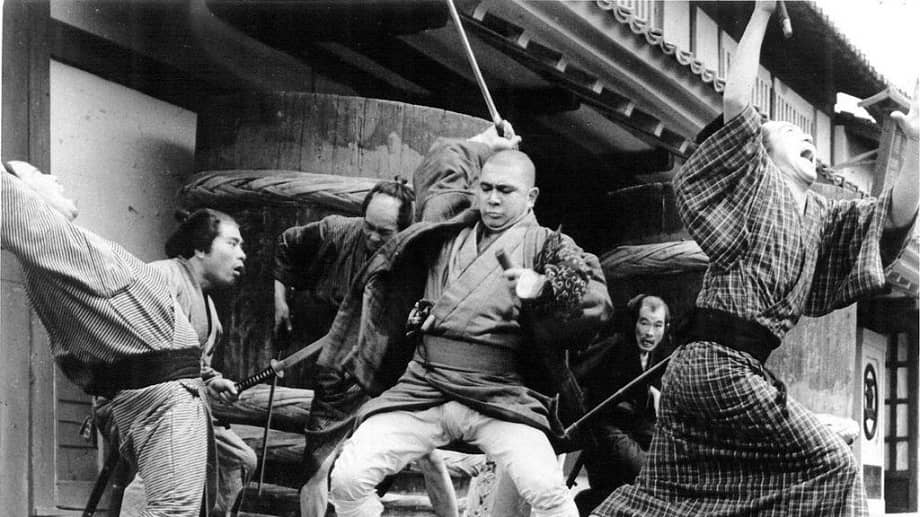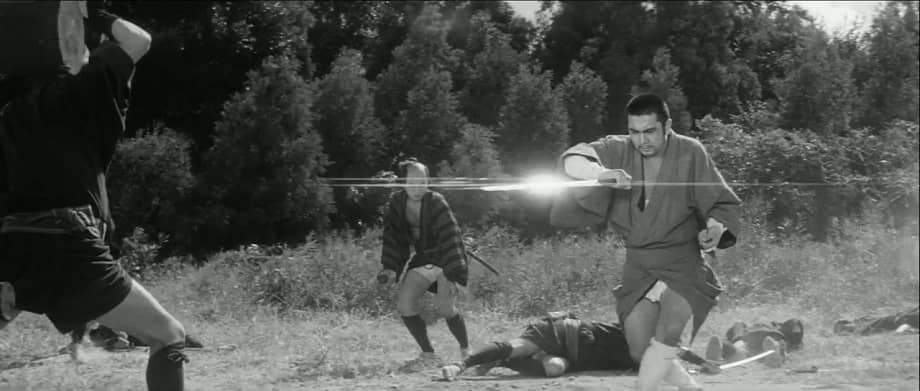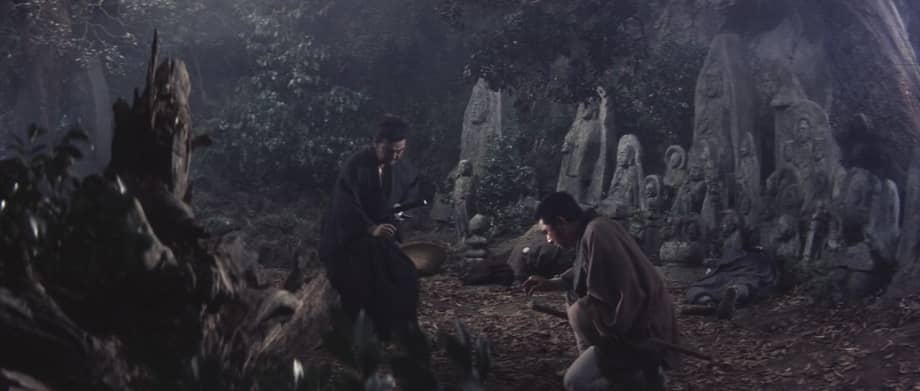Ellsworth’s Cinema of Swords: The Tale of Zatoichi
The Tale of Zatoichi (1962)
During the American occupation of Japan after World War II, one of its many social restrictions was a prohibition on the making of violent movies, which meant no historical samurai adventures. When the occupation was lifted in 1952, the chambara, or swordplay action films, gradually returned, and by the late Fifties they made up a significant portion of the movies and TV shows made for Japanese domestic consumption. Based on a story by the novelist Kan Shimozawa, The Tale of Zatoichi was just one more minor chambara feature, but Shintaro Katsu’s portrayal of the blind swordsman was surprisingly popular and the Zatoichi films went on to become the longest running chambara series of all, running to 25 feature films and four seasons as a TV series. And yet its hero is no noble samurai, or even a masterless ronin, but a mere low-ranking member of the criminal yakuza. Nonetheless, he’s a character you’ll never forget. Elements of the Zatoichi films showed up later in the Lone Wolf & Cub series, which in turn helped inspire The Mandalorian, so these films are relevant even today.
The Tale of Zatoichi
Rating: *****
Origin: Japan, 1962
Director: Kenji Misumi
Source: Criterion DVD
In Japan in the late Fifties and early Sixties, mid-level studios like Daei Motion Pictures churned out samurai action films and TV shows much like Hollywood did Westerns in the same period. These were mostly disposable and forgettable, and most have been duly forgotten. You can be sure that nobody who worked on The Tale of Zatoichi thought they were making anything but one more quickie chambara feature, but somehow they created a story that transcended its genre limitations and spawned the longest-running samurai series in Japanese film.
What made this film stand out from its contemporaries? First, it was lucky in its writer: Minoru Inuzuka was veteran screenwriter since the silent era who had a firm grasp of tight plotting and strong characters. Second, it was lucky in its director: Kenji Misumi was a visual master who’d been trained by the great Teinosuke Kinugasa (Gate of Hell), so good that he was often offered prestige dramas by the studio but he just preferred to make action films. Third and most important, it was lucky in its lead actor: Shintaro Katsu had played character and lead roles in a number of films for Daiei, but his portrayal of the tough but vulnerable blind swordsman Zatoichi struck a chord with audiences in Japan and eventually around the world.
You heard me right: blind swordsman. Zatoichi is a sightless masseur (massage was one of the few careers open to the blind in samurai-era Japan) who travels in the lowest levels of Japanese society among the yakuza, or organized crime gangs. A wanderer tapping his way with a cane, he arrives in the town of Iioka and goes directly to the town’s yakuza gambling den, where the local tough guys are wagering at dice. Zatoichi humbly asks if he can join the game and the thugs agree, eager to fleece the blind man of his money. And in fact, the masseur immediately loses half his coins to the cheating crooks, but then uses sleight of hand to win the next throw and get all his money back, doubled. The thugs are incensed, but strangely, the blind man isn’t intimidated by their threats. This mystery is solved by the return of local boss, who welcomes Zatoichi as an old acquaintance and warns his men that the blind man is actually an accomplished swordsman. But how can that be?
We learn as the story plays out: a gang war is imminent between the yakuza of Iioka and those of the neighboring town of Sasagawa, and the Iioka boss wants Zatoichi on his side to balance out the down-on-his-luck samurai Hirate (Shigeru Amachi) who’s been hired by Sasagawa. However, while away from the gang, Zatoichi strikes up an unlikely friendship with Hirate while they’re both fishing in a local lake. The other pivotal character is Otane (Masayo Banri), a spirited young woman whose brother and ex-boyfriend are in the yakuza but who wants to escape the gang life. It’s through eyes of these people, the gang bosses, the samurai, and the hopeful Otane, that we gradually see and understand Zatoichi’s many-sided character. With the yakuza he alternates between oily humility and curt bluster, demanding respect but according it only when he must. To the failed samurai, whom he senses is a gentle man of honor with a deadly disease, Zatoichi offers unconditional friendship. And to the wistful Otane, he reveals his loneliness and his guilt for the harm he’s caused during his years in the underworld.
And always, when he isn’t sniffing the plum blossoms or guzzling sake, Zatoichi is listening from the shadows. He puts together bits and pieces of overheard conversations until he understands all the intrigues, romantic, political, and criminal, of Iioka and Sasagawa, always with the aim of avoiding trouble, but inevitably coming to the aid of the innocent and helpless. And then his blind man’s cane pulls apart to reveal the straight sword blade hidden inside, and Zatoichi’s preternaturally sharp senses enable him to dodge blows and slay attackers with blindingly quick short slashes.
Zatoichi explains that as a blind man among the yakuza, he’d suffered so much scorn that he took up the sword because that was the only thing that would compel their respect—but use of it has only made him more of an outcast and stained him with blood he can never wash clean. It all ends in the bloody gang war that both Zatoichi and Hirate had hoped to avoid, but destiny decrees otherwise. Afterward Otane awaits Zatoichi on the highway out of Iioka to pledge her love to him, but the blind yakuza knows he’s unworthy of her and leaves by a side road, traveling ever onward to the next town.
The Tale of Zatoichi Continues
Rating: ****
Origin: Japan, 1962
Director: Kazuo Mori
Source: Criterion DVD
It was clear that the first film wasn’t intended as the beginning of a series, since at the end Zatoichi gave up the use of his cane sword and had it buried with his friend, the samurai Hirate. But the response to The Tale of Zatoichi was so positive that Daiei Motion Pictures rushed out this sequel to take advantage of it before the audience could forget and move on. What audiences loved the most was the character of Zatoichi himself, so the second film makes him central to every aspect of the plot and reveals much more of his history. Written and directed by Kazuo Mori, it’s fast and tight and packs a lot of plot into its 72 minutes; many fans consider it even better than the first one.
A year after the death of Hirate, Zatoichi (Shintaro Katsu) returns to region where he’s buried to commemorate him, but gets enmeshed in new intrigues, old grudges, and complications from his past. The new trouble comes when Zatoichi is engaged in his capacity as a masseur to tend to a samurai lord; he notices that the lord’s wits are badly addled, a fact the clan considers a closely guarded secret, so they decide to have Zatoichi killed. When he escapes their samurai, the clan hires Kanbei, the local yakuza boss, to track Zatoichi down and kill him, and Kanbei enlists the aid of his neighbor Sukegoro, the surviving boss from the first film, who has a score to settle.
But in addition to the two yakuza gangs, Zatoichi is being shadowed on his way to the cemetery by a wanted criminal named Yoshiro, played by Shintaro Katsu’s brother Tomisaburo Wakayama, which is an apt casting, as later events will show. We know from the first film that Zatoichi is rueful about his violent life, but now we see that he’s thoughtful and reflective as well. From Zatoichi’s musings, we learn that what set him on his life of wandering was the loss of the love of his life, a woman named Ochiyo, who was stolen from him by a man they both despised. In the town of Iioka, Zatoichi once more encounters Otane (Mazayo Banri), who is now engaged to an honest carpenter, but who risks her life to warn Zatoichi of the approach of Kanbei’s yakuza.
In the climax of the film, Zatoichi is pitted against an entire gang in the kind of set-piece battle that will become a hallmark of the series, and for the first time his unique fighting style, in which he holds his sword in a reverse grip and moves to get inside his opponents’ sword range, is displayed to its fullest. He also has a showdown with the criminal Yoshiro, and this time there’s a clear set-up for a subsequent film, as Yoshiro reveals a secret dear to Zatoichi’s heart.
New Tale of Zatoichi
Rating: *****
Origin: Japan, 1963
Director: Tokuzo Tanaka
Source: Criterion DVD
Zatoichi, whipsawed between love and fate! The Zatoichi stories are set circa 1840, when over two centuries of stable rule by the Tokugawa Shogunate is finally unraveling. Some samurai, no longer supported by the old social structure, take to crime, competing or collaborating with the yakuza, like the ex-samurai Tengu gang in this tale.
Zatoichi (Shintaro Katsu), wandering the highways, meets an itinerant musician from his hometown of Kasama and decides to return to his old environs. He makes it as far as neighboring Shimodate where he’s accosted by Yasuhiko (Fujio Suga), brother of that Boss Kanbei whom Zatoichi had slain in the previous installment. Yasuhiko’s revenge is forestalled by an interruption from a samurai named Banno (Seizaburo Kawazu), the sword master who’d taught Zatoichi how to fight. Banno is a master of iaijutsu, the attack on the draw, and Zatoichi learned his own mastery of the technique from him.
The sword master takes Zatoichi home where he meets Banno’s younger sister Yayoi (Mikiko Tsubouchi), who has been waiting for Ichi, as she calls him, to return for four years. But Banno, down on his luck, plans to marry Yayoi to a wealthy samurai lord and has no patience for her romantic dreams about Ichi. There are other complications: Yasuhiko shows up in town, still bent on revenge, while Banno has been having secret dealings with the Tengu gang. Ichi just wants to avoid trouble and find happiness but nearly everyone else has other ideas. He does find an ally where he’d expected only an enemy, but then is betrayed by someone he thought he could trust.
After the success of Zatoichi Continues, Daiei Motion Pictures finally realized they had a hit series on their hands and pumped up the budget for New Tale, shooting it in vibrant full color. Director Tokuzo Tanaka, who’d been an assistant director to Kurosawa, tells this tangled tale with complete clarity and an eye for composition and movement. The final fight between Zatoichi and the Tengu gang is superb, easily the best swordplay in the series so far, and it’s followed by a climactic iaijutsu duel that compares well to the one at the end of Sanjuro. If you’d prefer to skip the two earlier black-and-white entries, you could easily start the Zatoichi series here.
The previous installments in the Cinema of Swords are:
Olivia de Havilland — First Queen of the Swashbucklers
Goofballs in Harem Pants
Disney’s Early Swashbucklers
‘50s Vikings – Havoc in Horned Helms
Laughing Cavaliers
Charming and Dangerous: Douglas Fairbanks, Jr.
Eleven Samurai: Early Chambara Classics
Beyond Captain Blood: Three by Sabatini
3 Musketeers + 1 Long Nose
Louis Hayward, Everyman with a Sword (Part 1 of 2)
Days of Technicolor Knights
Louis Hayward, Everyman with a Sword (Part 2 of 2)
Laurence Olivier, Swashbuckler?
Tony Curtis Goes Yonda
The 7th Voyage and Its Children
The Good, the Bad, and Mifune
The First British Invasion
Wholesome Buccaneers (Pt. 1)
LAWRENCE ELLSWORTH is deep in his current mega-project, editing and translating new, contemporary English editions of all the works in Alexandre Dumas’s Musketeers Cycle, with the fourth volume, Blood Royal, just published by Pegasus Books in the US and UK. His website is Swashbucklingadventure.net.
Ellsworth’s secret identity is game designer LAWRENCE SCHICK, who’s been designing role-playing games since the 1970s. He now lives in Dublin, Ireland where he works as a consultant for narrative-based video games.



Another Cinema of Swords from Lawrence Ellsworth!
Zatoichi was almost an industry in itself, eventually spawning more than two dozen films and 100 TV episodes over a 25 year period. I’ve seen most of the films and part of the appeal for me was the glimpse it gave of a Japan away from the battlefields and the formal courts, a look at a world of people who weren’t noblemen or samurai. And of course, the swordplay.
Everyone should watch at least one Zatoichi film or show, and a great place to start is that 3rd film (New Tale of Zatoichi)as Mr. Ellsworth suggests. Its the first film in color, Shintaro Katsu has hit his stride in his role of a lifetime and the sword fighting is superb.
Thank you, Mr. Ellsworth.
Part of me always wondered how on earth a blind man could use a sword. That said I always liked the Zatoichi series. There is a sense of tragedy in it, since Zatoichi can never seem to escape violence even though he just wants to live peacefully.
@ Matthew
Daredevil says hi.
I love this series and recommend checking out the TV series if you can find it. I always wondered if he could see better than he let on…